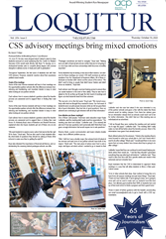 Shane Evans
Shane EvansAs part of her teaching technique, Dr. Nancy Watterson, one of the English department’s new additions, took the classroom into a whole new level: the gym. On Friday, Sept. 22, the Dixon center welcomed a capoeira workshop.
Capoeira is an over-400-year afro-Brazilian martial art. It is a combination of dance, music and fighting that forms into a cultural art-like game of kicks and dodges. Watterson decided that a practical way to start off her new courses would be to bring a workshop to her students.
“I’ve seen that it can work on several levels,” Watterson said. Watterson introduced her graduate students at the University of Pennsylvania, undergraduate students in Princeton and high school students from New Jersey to capoeira and was thrilled with the outcome. “With every class they have gotten something out of it, whether it was shared bonding or going through learning something that is unfamiliar,” Watterson said.
The workshop was to be in place of one of Watterson’s English 101 courses, writing about people, place and possibility. Watterson’s interest started when her godson began capoeira. She witnessed how positively it had influenced his life with confidence and discipline and thought it would work in academics as well. She felt that bringing this martial art to her classroom would place as an icebreaker for her freshmen students.
Friday started with an overview of the history of capoeira and then an explanation of the music and singing that drives the movements of the game.
Instructor Marcos Correa mentioned the fact that capoeira is catching onto popular culture in America, like being in films such as “Harry Potter and the Goblet of Fire” and “Meet the Fockers.” After that, the students in Watterson’s class and the capoeira group from the American Society of Capoeira and Arts from Brazil began doing stretches to prepare for the game. They all began to run around in a large circle for five minutes. Then Correa, also called Canguru to his students, showed how to balance while doing a handstand.
Everybody sat in a circle around Correa and the ASCAB capoeiristas, Portuguese for “player,” when the performance began, with a total of 13 people in the Dixon center. The instruments leading the game sounded. The berimbau, the atabaque and the pandeiro were the foreign instruments present. The berimbau is shaped like a bow and arrow and is strung with a steel wire. The atabaqu is shaped like a large drum and played the same. Lastly, the pandeiro looks like a tambourine and is also played like a drum. With all being played at the same time, the sense of Brazilian history was thriving in the room. The combination between the song played by the capoeiristas and the audience’s response to the song drove the competition between two capoeiristas fighting in the middle of the circle.
Historically, capoeira derived from the African slave’s self defense from the Brazilian slave-owners. The Africans were brought to Brazil as part of the slave trade. When the Dutch came, the slaves escaped to the forests of Brazil and practiced fighting in a way that looked like dance. When the slave owners came to find their slaves, the slaves had a new tactical way to fight back using not only hand combat, but foot combat too. Now, capoeira looks like fighting, but does not involve the hitting or kicking. The idea is to escape your opponents flying kicks with back flips, dodges and cartwheels. The end results in looking like a choreographed dance. From Brazilian tradition, capoeiristas wear white; the idea of wearing white first came from the thought that if one could wear white and not get dirty from the game, then they were very good.
Correa, born and raised in Brazil, first started capoeira when he was 26 years old. He initially caught interest in it when he was seven, but was forbidden to practice it by his father. Later when he moved to America, he ran into people from his country who practiced capoeira. He finally joined up and has taught and performed all around the North East coast including New York, New Jersey and Pennsylvania.
“The game can be played anyway you want. The game can be happy. The game can be sad. The game can be tough, or it can be weak. It can be rough, and it can be powerful,” Correa said.
Correa hopes that capoeira will catch onto Cabrini’s community and hopes to open up the interest in it by creating a one-credit physical education course starting in the fall.
“I think I would do it again. I thought it was relaxing and fun,” Kaitlin Dougherty, a freshman education major, said.


